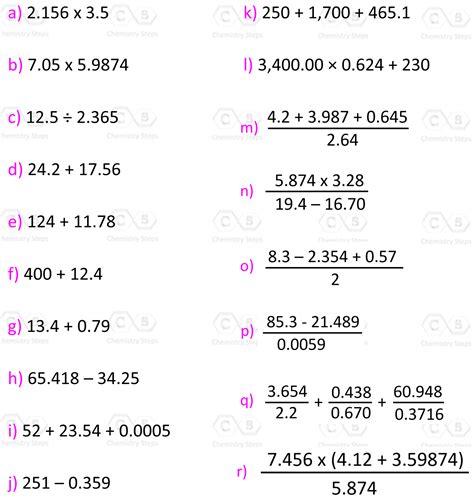Sig Fig Practice

Significant figures, or sig figs, are a fundamental concept in scientific measurement and data analysis. The practice of using significant figures ensures that the precision of a measurement or calculation is accurately represented, preventing the misleading impression of greater precision than actually exists. Understanding and applying significant figures correctly is crucial in various fields, including physics, chemistry, biology, and engineering, as it affects the validity and reliability of scientific results and conclusions.
Introduction to Significant Figures

Significant figures are the digits in a measurement that are known to be reliable and certain, including the last digit which is estimated. The number of significant figures in a measurement depends on the precision of the instrument used to make the measurement. For example, a ruler that can measure lengths to the nearest millimeter has a higher precision than one that can only measure to the nearest centimeter. The rules for counting significant figures are straightforward: all non-zero digits are significant, zeros between non-zero digits are significant, and zeros at the end of a number are significant if the number contains a decimal point. However, if there is no decimal point, trailing zeros may or may not be significant, depending on the context.
Rules for Significant Figures
There are specific rules to follow when determining the number of significant figures in a measurement or calculation. Firstly, all non-zero digits are considered significant. For instance, in the number 123, all three digits are significant. Secondly, zeros between non-zero digits are also significant, as seen in the number 101, where the zero is significant. Thirdly, trailing zeros in a number with a decimal point are significant, such as in 12.30, where both the 2 and the 0 are significant. However, if a number does not have a decimal point, trailing zeros may not be significant unless the measurement is specified to have a certain number of significant figures. For example, 1200 could have 1, 2, 3, or 4 significant figures depending on the context in which it is given.
| Number | Significant Figures |
|---|---|
| 123 | 3 |
| 101 | 3 |
| 12.30 | 4 |
| 1200 | Variable |

Operations with Significant Figures

When performing calculations involving measurements with significant figures, there are rules to apply to ensure the result has the correct number of significant figures. For addition and subtraction, the result should have the same number of decimal places as the measurement with the fewest decimal places. For multiplication and division, the result should have the same number of significant figures as the measurement with the fewest significant figures. Rounding rules are also crucial: when adding or subtracting, round the final answer to the least number of decimal places of any of the original numbers, and when multiplying or dividing, round the final answer to the least number of significant figures of any of the original numbers.
Examples of Significant Figure Calculations
For example, if you are adding 12.34 and 2.1, the result should be rounded to one decimal place because 2.1 has only one decimal place. Thus, 12.34 + 2.1 = 14.4. In multiplication, if you multiply 12.3 by 2.1, the result should have two significant figures because 2.1 has the fewest significant figures. Thus, 12.3 * 2.1 = 26.
| Operation | Example | Result |
|---|---|---|
| Addition | 12.34 + 2.1 | 14.4 |
| Multiplication | 12.3 * 2.1 | 26 |
Key Points
- Significant figures are crucial for accurately representing the precision of measurements and calculations.
- The rules for counting significant figures include considering all non-zero digits, zeros between non-zero digits, and trailing zeros in numbers with a decimal point as significant.
- When performing calculations, the number of significant figures in the result depends on the operation (addition/subtraction vs. multiplication/division) and the significant figures of the original measurements.
- Rounding rules must be applied to ensure the result has the correct number of significant figures or decimal places.
- Understanding and correctly applying significant figures is essential for maintaining the integrity and reliability of scientific data and conclusions.
Conclusion and Future Directions
In conclusion, significant figures play a vital role in scientific measurement and calculation, ensuring that data is represented with the appropriate level of precision. By understanding and applying the rules for significant figures, scientists can maintain the integrity of their data and draw more accurate conclusions. As science continues to evolve, the importance of significant figures will endure, highlighting the need for continued emphasis on precision and accuracy in measurement and calculation.
What is the purpose of using significant figures in scientific measurements?
+The purpose of using significant figures is to accurately represent the precision of a measurement, preventing the misleading impression of greater precision than actually exists.
How do you determine the number of significant figures in a measurement?
+The number of significant figures is determined by counting all non-zero digits, zeros between non-zero digits, and trailing zeros in numbers with a decimal point, while considering the context for numbers without a decimal point.
What are the rules for operations involving significant figures?
+For addition and subtraction, the result should have the same number of decimal places as the measurement with the fewest decimal places. For multiplication and division, the result should have the same number of significant figures as the measurement with the fewest significant figures.
Meta Description: Learn about significant figures and their role in scientific measurement, including rules for counting significant figures and performing calculations with precision and accuracy.